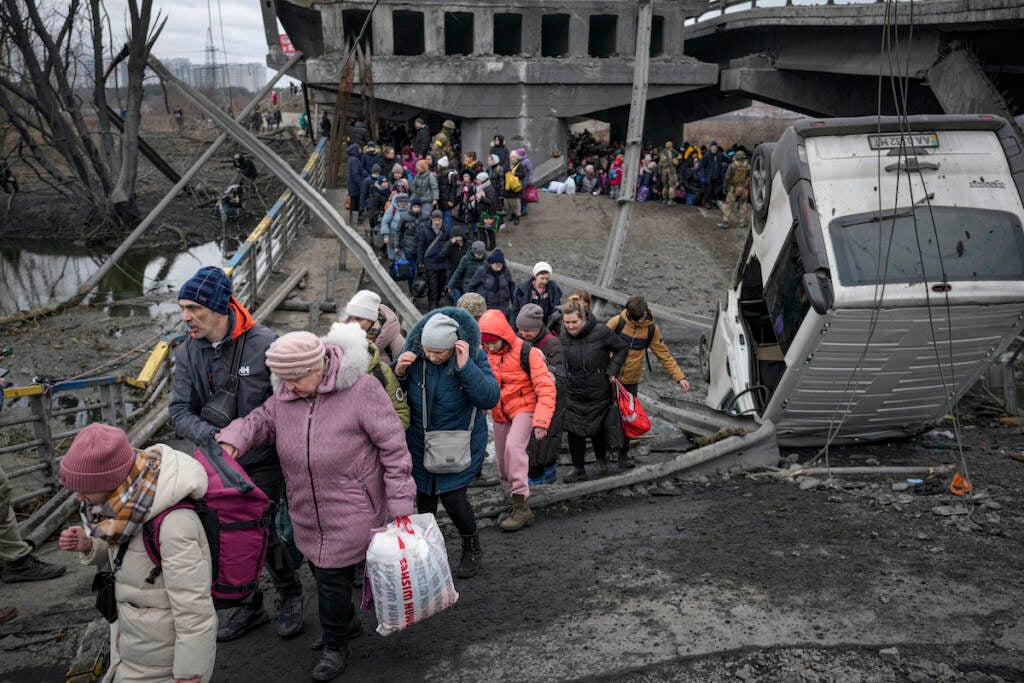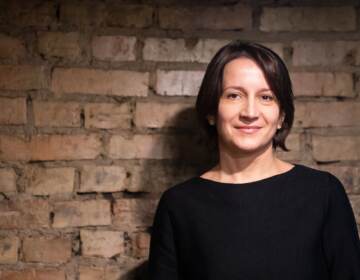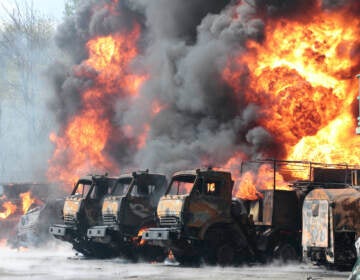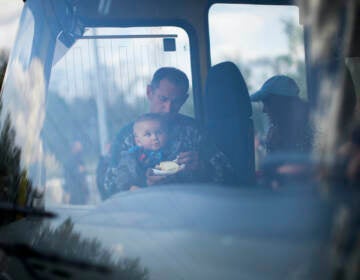Russian war in Ukraine marks 1 month with no end in sight
The largest military conflict in Europe since World War II has upset the international security order and sent dangerous ripples through the global economy.

A woman walks outside a maternity hospital that was damaged by shelling in Mariupol, Ukraine, Wednesday, March 9, 2022. (AP Photo/Evgeniy Maloletka, File)
Russia’s war in Ukraine has killed thousands of people, reduced entire cities to rubble and forced millions to flee their homes. The largest military conflict in Europe since World War II has also upset the international security order and sent dangerous ripples through the global economy.
A look at pivotal moments of the conflict, a month later:
The road to war
In early 2021, a buildup of Russian troops near Ukraine raised fears of an offensive. Moscow withdrew some of the forces in April, paving the way for a June summit between President Joe Biden and Russian President Vladimir Putin. Their meeting failed to meaningfully ease Russia-U.S. tensions, however.
A renewed buildup of Russian troops along Ukrainian borders began in late October and reached an estimated 150,000 troops by the year’s end. From the beginning of the troop surge, Moscow denied any plans to attack Ukraine, calling such Western concerns part of a campaign to discredit Russia. At the same time, it urged the U.S. and its allies to keep Ukraine from joining NATO and roll back the alliance forces from Eastern Europe, demands the West rejected as non-starters.
Then on Feb. 21, Putin abruptly upped the ante, recognizing the independence of pro-Russia rebel regions in eastern Ukraine. Insurgents have been fighting Ukrainian forces there since 2014, when Ukraine’s Moscow-friendly president was driven from office by mass protests and Russia responded by annexing the Crimean Peninsula.

Russian invasion begins
In a televised address on Feb. 24, Putin announced the launch of what he called a “special military operation” intended to demilitarize Ukraine and uproot alleged “neo-Nazi nationalists.” As he spoke, the Russian military unleashed a series of air raids and missile strikes on Ukraine’s military facilities and key infrastructure. Russian troops rolled into Ukraine from Crimea in the south, all along the eastern border and from Moscow’s ally Belarus, which borders Ukraine from the north.
Putin argued that Russia had no choice but to act after Washington and its allies ignored its demand for security guarantees. Western leaders dismissed the claims as a false pretext for the attack.
The Russian military advanced on the Ukrainian capital, Kyiv, located just 75 kilometers (47 miles) south of the border with Belarus, closed in on Ukraine’s second-largest city of Kharkiv in the east and pushed along the Sea of Azov and Black Sea coasts in the south.
While Russia claimed it was only targeting military facilities, air raids and artillery strikes hit residential areas, schools and hospitals across Ukraine.
The assault turned particularly deadly in March:
— On March 1, a Russian rocket hit the regional administration building in Kharkiv, killing 24.
— On March 9, a Russian airstrike devastated a maternity hospital in the besieged port of Mariupol, killing at least three and injuring 17.
— On March 16, a Russian bomb flattened a historic theater in Mariupol, even after Ukrainians had scrawled the word ‘children’ in huge white letters on the pavement next to it to indicate that civilians were sheltering inside. Officials said hundreds of people who were hiding in the basement survived.
— On Monday, at least eight people died in a Russian airstrike on a shopping mall in Kyiv.
Russia’s top objective in the south is Mariupol, a strategic port on the Sea of Azov that has been under siege for weeks. Relentless bombardment by the Russians has reduced entire neighborhoods to rubble and killed thousands, turning the city into an emblem of civilian suffering.
Thousands have fled the city, part of a wave of refugees fleeing the country that United Nations officials estimate at more than 3.5 million.

Russia stung by Western sanctions
Western allies quickly responded to the invasion with unprecedented economic and financial sanctions.
Several waves of crippling penalties froze an estimated half of Russia’s $640 billion hard-currency reserves, cut key Russian banks out of the SWIFT financial messaging system, barred Moscow from getting cash in dollars and euros and targeted broad sectors of the Russian economy with rigid trade restrictions. Major international companies moved quickly to leave the Russian market.
The severe measures — of a magnitude previously only levied against such countries as Iran and North Korea — sent the ruble into a nosedive, provoked a run on deposits and triggered consumer panic.
Russian authorities responded by introducing tight restrictions on hard-currency transactions and stock markets.
Ukraine pleads for more weapons, no-fly zone
While hailing Western sanctions and weapons supplies, Ukrainian President Volodymyr Zelenskyy has challenged the U.S. and other Western allies to take even stronger measures to stop Russia.
He has continuously urged the U.S. and NATO to declare a no-fly zone over Ukraine, a demand the allies rejected for fear that it could result in a direct confrontation with Russia and even spark a global conflict.
Zelenskyy also has pleaded with Western allies to provide Ukraine with warplanes and long-range air defense systems. Russia has sternly warned the West against such a move, and discussions on possible deliveries of Soviet-era fighter jets and air defense weapons from Eastern Europe to Ukraine have stalled as the West seeks to avoid a dangerous escalation.
Ukraine has also asked the U.S. and the EU to ramp up sanctions to include a ban on Russian oil and gas exports, a move opposed by many EU members that depend on Russia for a large share of their energy needs.

Russian offensive bogs down
From the first days, the invasion hasn’t gone the way Putin expected. After quickly advancing to the outskirts of Kyiv in the first days of the invasion, Russian troops soon got bogged down in the suburbs.
Instead of surrendering as the Kremlin hoped, Ukrainian troops fought back fiercely in every sector, thwarting Russian attempts to quickly roll into other large cities, including Kharkiv and Chernihiv. Russia also failed to win full control of the skies over Ukraine despite massive strikes targeting the country’s air force and air defense assets.
Russian military convoys have stretched for dozens of kilometers (miles) along a highway leading from Belarus, becoming an easy target for Ukrainian raids and ambushes. In the east, the Russian troops have faced reinforced Ukrainian positions in the rebel regions and made only incremental gains.
And despite their hold on Mariupol, and a quick capture of the ports of Berdyansk and Kherson, the Russians’ have failed to capture the key shipbuilding center of Mykolaiv and press the offensive farther west toward Odesa.
Western officials say that throughout the war, Russian troops have been hampered by persistent supply shortages, struggling to get food and fuel and lacking proper cold weather gear.
In early March, the Russian military reported the loss of 498 soldiers, then never updated the toll again. In stark contrast, NATO estimated on Wednesday that 7,000 to 15,000 Russian troops were killed in four weeks of fighting. By way of comparison, the Soviet Union lost about 15,000 troops over a 10-year period during the war in Afghanistan.
Nuclear threats, chemical weapons fears
On the very first day of the assault, Russian forces took control of the decommissioned Chernobyl nuclear power plant, where radioactivity is still leaking from history’s worst nuclear disaster 36 years ago.
Several days later, they seized the Zaporizhzhia nuclear power plant, Europe’s largest, hitting a training center there and sparking a brief fire that raised fears of a catastrophe until it was put out.
And on Wednesday, Russian military forces destroyed a new laboratory at Chernobyl, according to the Ukrainian state agency responsible for the Chernobyl exclusion zone.
The international community has raised concerns about both plants’ safety.
There have been other threats as well.
On March 21, an ammonia leak at a chemical plant in the eastern Ukrainian city of Sumy contaminated an area with a radius of more than 2.5 kilometers (1.5 miles) but didn’t hurt any civilians in the city of 263,000 because the wind didn’t blow in that direction.
The Russian military has repeatedly alleged that Ukrainian “nationalists” are hatching plans to blow up a nuclear or chemical facility and then blame it on the Russians — warnings that Western officials fear could herald such an attack from Russia.
Many in the West also fear that with the Russian offensive stalled, Putin could order the use of tactical nuclear weapons or chemical weapons to scare Ukraine and bring it to its knees.

What’s next
Even as his offensive stalls and the Russian economy shudders under the blow of Western sanctions, Putin shows no sign of backing down.
Despite the plummeting ruble and soaring consumer prices, Russian polls show robust support for Putin. Observers attribute those results to the Kremlin’s massive propaganda campaign and crackdown on dissent.
Putin demands that Ukraine adopt a neutral status, drop its bid to join NATO, agree to demilitarize, recognize Russia’s sovereignty over Crimea and acknowledge the independence of the rebel republics in the Donbas region.
Zelenskyy said earlier this week that Ukraine is ready to discuss a neutral status along with security guarantees that would preclude any further aggression. But he’s said the status of Crimea and the separatist regions could be discussed only after a cease-fire and the withdrawal of Russian troops.
Putin may now hope to gain more ground and negotiate from the position of force to strong-arm Zelenskyy into making concessions. Russian and Ukrainian negotiators say they are still far from drafting a prospective deal that Putin and Zelenskyy could discuss.
WHYY is your source for fact-based, in-depth journalism and information. As a nonprofit organization, we rely on financial support from readers like you. Please give today.






